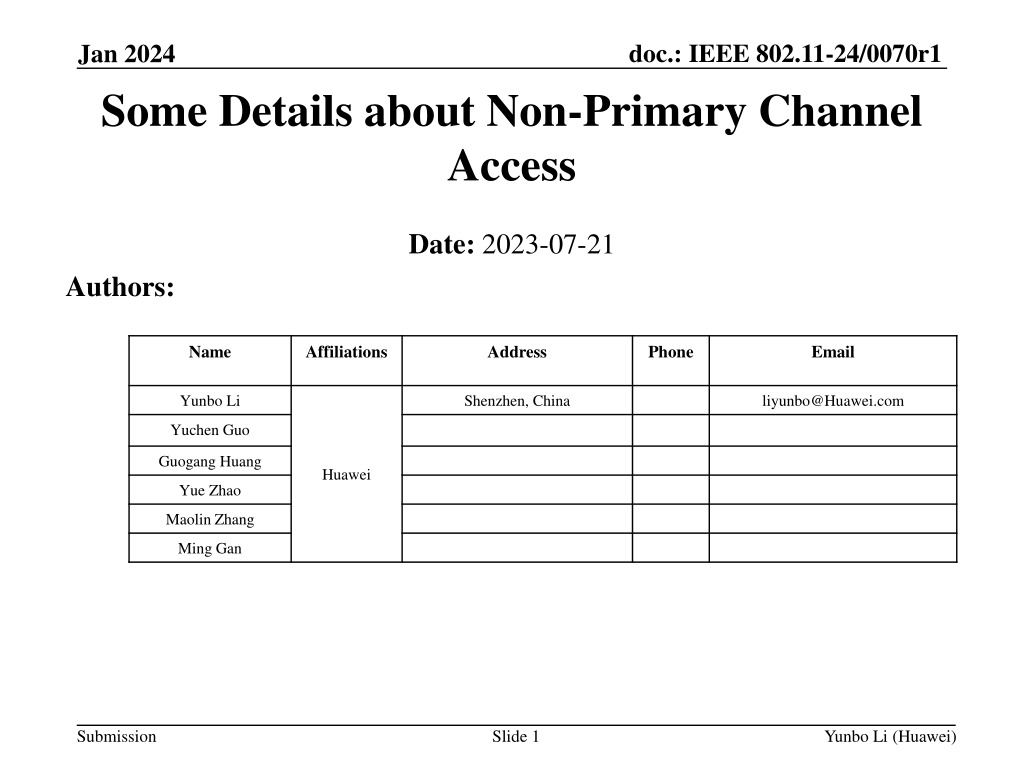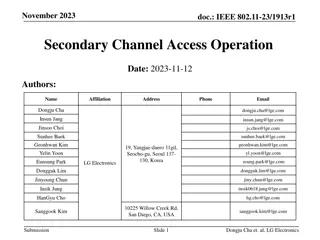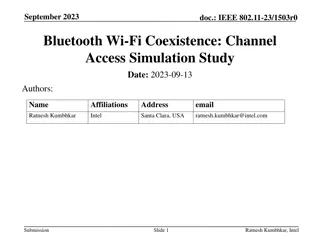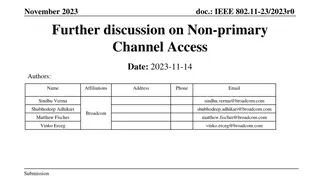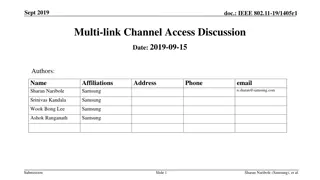IEEE 802.11-24/0070r1 Presentation on Non-Primary Channel Access
This presentation discusses the concept of using secondary channels for PPDU transmission in IEEE 802.11 networks to improve efficiency in large bandwidth scenarios. It covers topics such as channel access, backoff mechanisms, and channel switching thresholds. Design principles emphasize minimal impact on primary channel access and reusing existing mechanisms. High-level concepts include channel access on primary and anchor channels for STAs within a BSS. Considerations for setting the Basic NAV and identifying available sub-channels are also addressed.
Download Presentation

Please find below an Image/Link to download the presentation.
The content on the website is provided AS IS for your information and personal use only. It may not be sold, licensed, or shared on other websites without obtaining consent from the author. Download presentation by click this link. If you encounter any issues during the download, it is possible that the publisher has removed the file from their server.
E N D
Presentation Transcript
doc.: IEEE 802.11-24/0070r1 Jan 2024 Some Details about Non-Primary Channel Access Date: 2023-07-21 Authors: Name Affiliations Address Phone Email Yunbo Li Shenzhen, China liyunbo@Huawei.com Yuchen Guo Guogang Huang Huawei Yue Zhao Maolin Zhang Ming Gan Submission Slide 1 Yunbo Li (Huawei)
doc.: IEEE 802.11-24/0070r1 Jan 2024 Introduction For >20MHz operation, any PPDU must be transmitted on a channel that include the primary 20MHz sub-channel; When the primary 20MHz sub-channel is busy, secondary sub- channels can not be used for PPDU transmission even they are in idle status, which cause inefficiency for large bandwidth; The concept of utilize secondary channel was discussed in several UHR presentations; Opinions of following topics will be shared in this presentation: Bandwidth for basic NAV CCA on anchor channel Backoff counter on anchor channel Time threshold for channel switch Non-primary channel contention on/off Submission Slide 2 Yunbo Li (Huawei)
doc.: IEEE 802.11-24/0070r1 Jan 2024 Design Principle No major additional transmit and receive capability for AP and STA; Minimum or no affect on channel access on primary channel; Reuse current channel access mechanism as much as possible. Submission Slide 3 Yunbo Li (Huawei)
doc.: IEEE 802.11-24/0070r1 Jan 2024 High Level concepts A STA do channel access on primary channel; After the STA set basic NAV based on a received inter-BSS PPDU, it may switch to an anchor channel The anchor channel is predefined or announced by AP The anchor channel is common for all STAs within a BSS The anchor channel is one 20MHz sub-channel in secondary channel The STA may do channel access and frame exchanges on the anchor channel; The STA switches back to primary channel before the basic NAV expired. Submission Slide 4 Yunbo Li (Huawei)
doc.: IEEE 802.11-24/0070r1 Jan 2024 Bandwidth for Basic NAV Currently, a STA doesn t need to record the BW when setting the Basic NAV; Before a STA initiates channel access on the anchor channel, it needs to identify which secondary sub-channels are not occupied by the OBSS transmission on primary channel; If there are multiple anchor channels, the STA also needs to identify which secondary sub-channels are neither occupied by the OBSS transmission on primary channel, nor occupied by the OBSS transmission on the anchor channel with higher priority. Assume each anchor channels with different priorities. Submission Slide 5 Yunbo Li (Huawei)
doc.: IEEE 802.11-24/0070r1 Jan 2024 CCA on Anchor Channel When a STA switches to the anchor channel, it lacks of NAV info on anchor channel; It is similar as blindness that happens in NSTR/EMLSR/EMLMR operation; We can leverage some designs of channel access in blindness for anchor channel operation, which include below main points MediumSyncDelay timer = aPPDUMaxTime ED threshold (default) = -72dBm Max # of RTS Since the STA will switch back to primary channel before basic NAV expires, a timer (i.e. MediumSyncDelay timer) for channel access on anchor channel is not required; It would be nice to have a lower ED threshold to respect the OBSS transmission on anchor channel. The STA is required to initiate transmission using (MU-)RTS to reduce the probability of Data frame collisions, but a maximum number is not needed; Submission Slide 6 Yunbo Li (Huawei)
doc.: IEEE 802.11-24/0070r1 Jan 2024 Backoff Counter The CW and BO counter of a STA closely related to the channel contention history on primary channel. To keep the fairness among the STAs on primary channel, a STA s CW and BO counter on primary channel shall not be affected by the channel access on anchor channel; A separate backoff is needed for the anchor channel; The STA only opportunistically operate on anchor channel, how to maintain the CW and BO counter on anchor channel? Record the CW and BO counter when the STA operated on anchor channel last time, Or, Make is simpler, e.g. always initiate from a random number within [0, CW_min] Submission Slide 7 Yunbo Li (Huawei)
doc.: IEEE 802.11-24/0070r1 Jan 2024 Time threshold for channel switch There are some fixed overhead after switch to the anchor channel. Channel switch delay Time for channel contention Initial control frame If the basic NAV on primary channel is short, it doesn t make sense for a STA to do channel switch; No channel switch for a short NAV period will benefit for STA s power save; The value of this time threshold can be further discussed. Submission Slide 8 Yunbo Li (Huawei)
doc.: IEEE 802.11-24/0070r1 Jan 2024 Anchor Channel ON/OFF AP and associated STAs, in a scenario with little hidden nodes, will coordinate the switch between operating on the primary channel and anchor channel; In a scenario that AP and associated STAs cannot coordinated the switch between primary channel and anchor channel, a mechanism to suspend the channel access on Anchor channel is required; The anchor channel ON/OFF is BSS level or per STA based can be discussed For BSS level based, AP will broadcast a signaling to enable/disable channel access on anchor channel For per STA based, each STA could inform anchor channel ON/OFF individually to AP. It will be much flexible but also more complex for AP to manage. Submission Slide 9 Yunbo Li (Huawei)
doc.: IEEE 802.11-24/0070r1 Jan 2024 Conclusion Some further discussion on non-primary channel access A STA needs to record the BW when set Basic NAV, in order to understand which secondary sub-channels are available now; Reuse part of CCA design for blindness A separate backoff counter is suggested for anchor channel A time threshold for channel switch will benefits for power save It is good to suspend the channel access on anchor channel under some cases (e.g. hidden nodes scenario) Submission Slide 10 Yunbo Li (Huawei)
doc.: IEEE 802.11-24/0070r1 Jan 2024 SP 1 Do you agree that, when a STA that support non-primary channel access transmits on non-primary channel, its transmitting channel shall follows below requirements? The transmitting channel is within the STA s operating channel; The transmitting channel is not overlapping with the transmitting channel of OBSS PPDU on the primary channel Submission Slide 11 Yunbo Li (Huawei)
doc.: IEEE 802.11-24/0070r1 Jan 2024 SP 2 Do you agree that, when a STA that support non-primary channel access intend to transmit on non-primary channel, it shall follows below requirements? The CCA ED threshold shall less than -62 dBm; The transmission shall initiate with a control frame (e.g. RTS). Submission Slide 12 Yunbo Li (Huawei)
doc.: IEEE 802.11-24/0070r1 Jan 2024 SP 3 Do you agree that, when a STA that support non-primary channel access do channel access on secondary channel, it shall use another set of parameters which is separate from EDCA parameters on primary channel? Submission Slide 13 Yunbo Li (Huawei)
doc.: IEEE 802.11-24/0070r1 Jan 2024 SP 4 Do you agree that, when a STA that support non-primary channel access shall not switch to secondary channel if the Basic NAV on primary channel is less than a time threshold? The value of the time threshold is TBD Submission Slide 14 Yunbo Li (Huawei)
doc.: IEEE 802.11-24/0070r1 Jan 2024 SP 5 Do you agree that, when a STA that support non-primary channel access may enable or disable its non-primary channel access operation? The conditions of enable or disable non-primary channel assess operation are TBD Submission Slide 15 Yunbo Li (Huawei)
